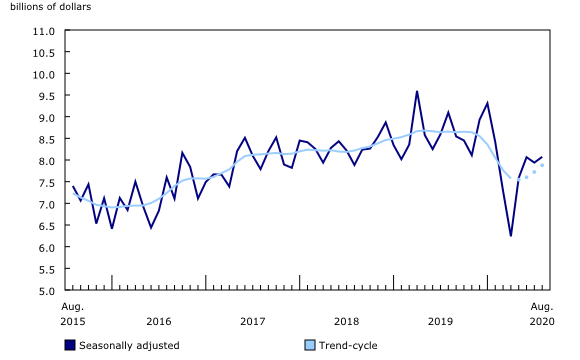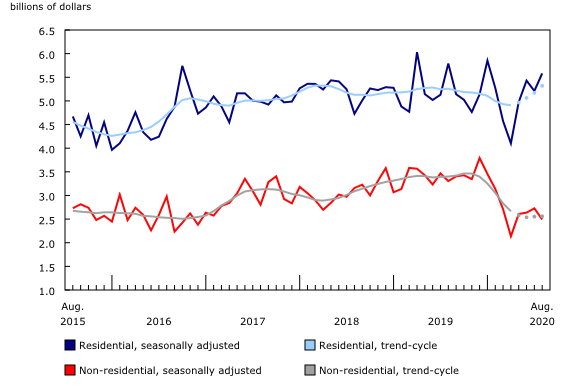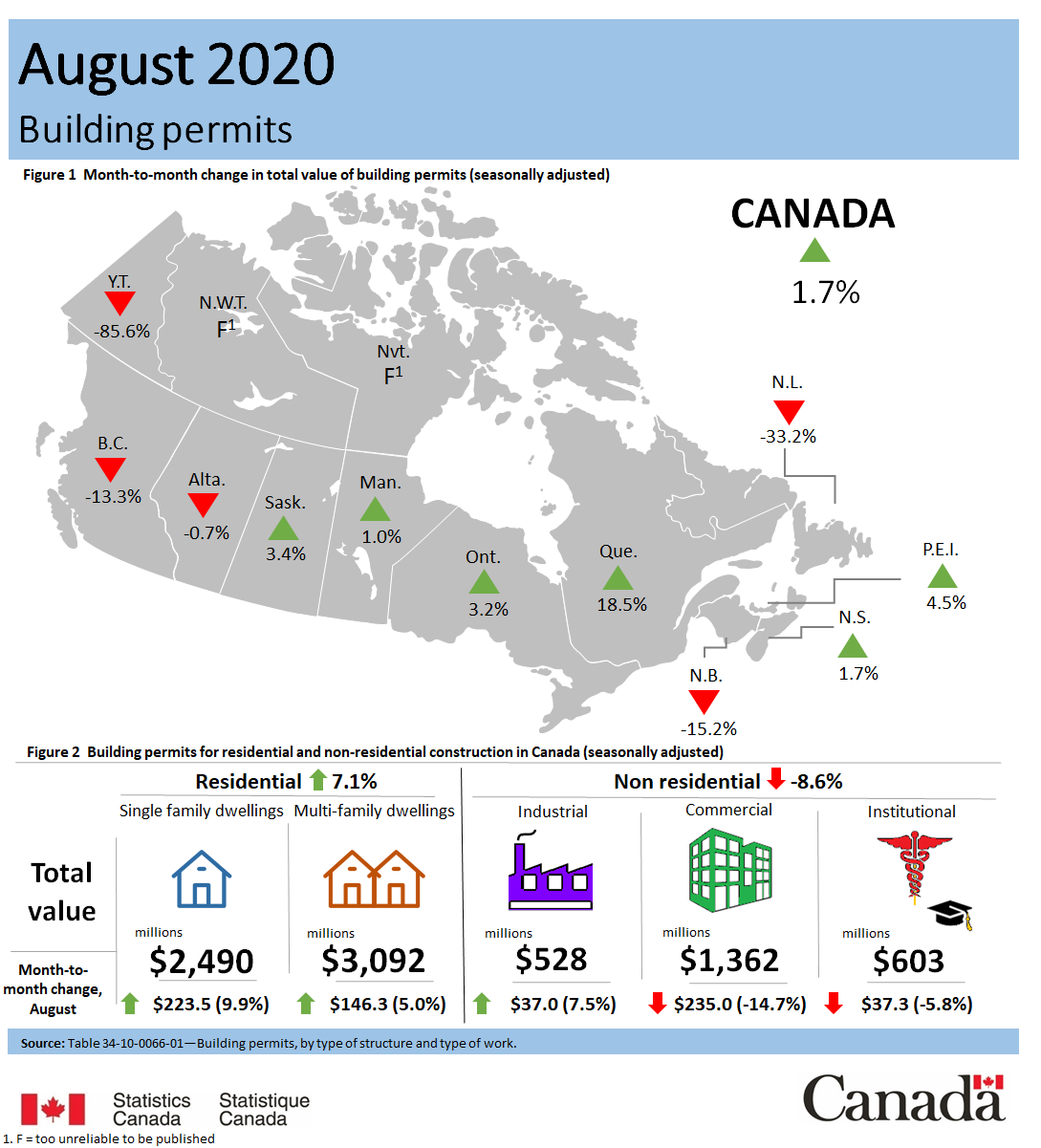Building permits, August 2020
Archived Content
Information identified as archived is provided for reference, research or recordkeeping purposes. It is not subject to the Government of Canada Web Standards and has not been altered or updated since it was archived. Please "contact us" to request a format other than those available.
Released: 2020-10-01
$8.1 billion
August 2020
1.7% 
(monthly change)
$34.1 million
August 2020
-33.2% 
(monthly change)
$59.0 million
August 2020
4.5% 
(monthly change)
$129.2 million
August 2020
1.7% 
(monthly change)
$83.8 million
August 2020
-15.2% 
(monthly change)
$1,770.3 million
August 2020
18.5% 
(monthly change)
$3,606.1 million
August 2020
3.2% 
(monthly change)
$269.5 million
August 2020
1.0% 
(monthly change)
$103.9 million
August 2020
3.4% 
(monthly change)
$896.6 million
August 2020
-0.7% 
(monthly change)
$1,111.2 million
August 2020
-13.3% 
(monthly change)
$6.9 million
August 2020
-85.6% 
(monthly change)
F
August 2020
F
(monthly change)
F
August 2020
F
(monthly change)
The total value of building permits rose 1.7% to $8.1 billion in August, driven by an increase in the residential sector in Ontario and Quebec.
Single homes drive increase in residential sector
Permits issued for single family homes rose 9.9% to $2.5 billion in August, continuing the upward trend observed since May. Eight provinces reported increases in this component, with Ontario accounting for more than half of the national gain, mostly due to permits issued in the census metropolitan areas of Toronto (+12.7%), Oshawa (+94.2%) and Brantford (+257.4%).
Seven provinces showed a decline in the value of permits issued for multi-family dwellings in August, with British Columbia (-28.7%) falling for a second month to $440 million. Excluding March 2020, this was the lowest value reported for multi-family dwellings in British Columbia since March 2017. Despite the majority of provinces reporting declines, the total value of permits issued for multi-family dwellings rose 5.0% nationally, mainly as a result of permits issued in Ontario and Quebec.
Overall, the total value of residential permits increased by 7.1% to $5.6 billion.
Commercial and institutional permits fall in August
The total value of non-residential permits fell 8.6% to $2.5 billion in August, largely due to permits issued in Ontario (-15.7%). Only Quebec (+9.9%), Prince Edward Island (+82.2%) and Nova Scotia (+16.7%) posted increases in this sector.
Commercial permits fell by 14.7% to $1.4 billion in August, following a notable gain in July reflecting the half-billion dollar permit for Project Python in Ottawa. Overall, the total value of permits for commercial buildings was lower for January to August of 2020 when compared with the same period in 2019. In particular, the unadjusted value of permits issued for office building renovations fell 14.1%. This reflects changing priorities during the pandemic as many offices have closed or reduced on-site staff while more employees work from home.
Institutional permits declined for a second month, falling 5.8% to $603 million. Ontario (-27.9%) recorded the most significant drop in the value of permits issued of all the provinces, more than offsetting gains in Quebec (+30.3%).
Following two months of decline, the total value of industrial permits increased in August, up 7.5% to $528 million. Permits issued in Ontario (+41.4%) and British Columbia (+61.5%) accounted for most of the gains.
To explore the impact of COVID-19 on the socioeconomic landscape, please visit the Canadian Economic Dashboard and COVID-19.
For more information on housing, please visit the Housing statistics portal.
Note to readers
Unless otherwise stated, this release presents seasonally adjusted data, which facilitate month-to-month comparisons by removing the effects of seasonal variations. For information on seasonal adjustment, see Seasonally adjusted data – Frequently asked questions.
The Building Permits Survey covers over 2,400 municipalities, representing 95% of the Canadian population. The communities representing the other 5% of the population are very small, and their levels of building activity have little impact on the total for the entire population.
Building permit data are used as a leading indicator of activity in the construction industry.
The value of planned construction activities presented in this release excludes engineering projects (such as waterworks, sewers or culverts) and land.
For the purposes of this release, the census metropolitan area of Ottawa–Gatineau (Ontario and Quebec) is divided into two areas: the Ottawa part and the Gatineau part.
Unless otherwise specified, the highlights refer to seasonally adjusted current dollars and are ranked in terms of dollar change rather than percentage change.
Building components
Single-family dwellings: Residential buildings containing only one dwelling unit (for example, single-detached house, bungalow, linked home [linked at the foundation]).
Multi-family dwellings: Residential buildings containing multiple dwelling units (for example, apartment, apartment condominium, row house, semi-detached house).
Industrial buildings: Buildings used in the processing or production of goods, or related to transportation and communication.
Commercial buildings: Buildings used in the trade or distribution of goods and services.
Institutional and government buildings: Buildings used to house public and semi-public services, such as those related to health and welfare, education, or public administration, as well as buildings used for religious services.
Revision
Unadjusted data for the current reference month are subject to revision based on late responses. Data for the previous two months have been revised. Seasonally adjusted data for the previous three months have also been revised.
Trend-cycle estimates have been added to the charts as a complement to the seasonally adjusted series. Both seasonally adjusted data and trend-cycle estimates are subject to revision as additional observations become available. These revisions could be large and could even lead to a reversal of movement, especially at the end of the series. The higher variability associated with trend-cycle estimates is indicated with a dotted line on the chart.
For information on trend-cycle data, see the StatCan Blog and Trend-cycle estimates – Frequently asked questions.
Contact information
For more information, or to enquire about the concepts, methods or data quality of this release, contact us (toll-free 1-800-263-1136; 514-283-8300; STATCAN.infostats-infostats.STATCAN@canada.ca) or Media Relations (613-951-4636; STATCAN.mediahotline-ligneinfomedias.STATCAN@canada.ca).
- Date modified:






